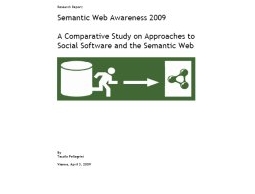Learn more
- Apr 17, 2009
Now available: Results of the Semantic Web Awareness Barometer 2009

We recommend to read this report as a snapshot on the development of the Semantic Web. It shall give the reader a brief overview over current trends and possible future topics. It shall provide orientation at a broader scale that helps the reader to compare his/her personal notion of the current development with the aggregated views from other specialists. Beside that, the results of this survey can be used to formulate further hypotheses for testing under more advanced empirical circumstances.
For better orientation we grouped the respondents by their approach to the topic into Research-oriented and Application-oriented. While the first category consists mainly of stakeholders from the academic or industrial scientific sector, the latter category consists of interested users and decision makers with an industrial background.
The results in brief:
Social Software
- There exist slightly differing application and usage patterns of Social Software between the two groups, but the general trend says: Wikis are king! Social Bookmarking stays behind.
- There exists broad consent about the benefits of Social Software. Both groups say that quick access to information and knowledge is the biggest benefit generated by Social Software, followed by social networking functionalities and ubiquitous access to documents and data.
- There are differring notions about the barriers to Social Software, but consent exists that the amount of time necessary to use and maintain Social Software applications is the biggest obstacle.
Semantic Web
- The overall Semantic Web familiarity is already rather high.
- Most participants, especially from the research-domain, have dealt with the topic for more than three years. Application-oriented users catch up.
- When it comes to Semantic Web education self-study is the general pattern among both groups.
- More than 80 percent of application-oriented and research-oriented participants think that Semantic Web technologies are at least relevant to be used for corporate and business purposes.
- Search is the killer app! Integration costs & data control might be important aspects.
- There exist differring notions about the importance of certain barriers to the Semantic Web. Application-oriented participants believe that the organisational culture, the complexity of the technology, a general lack of experts and a lack of success stories are the biggest obstacles to the application of Semantic Web technologies. On the contrary research-oriented participants believe that the lack of success stories, a gerenal lack of experts, a lack in quality of available software and the problem to quantify the benefits will hinder the broad adoption.
- While just a small minority believes that there won’t be any changes at all, most participatns expect changes in regard to competencies of the knowledge worker and new forms of collaboration either between or within companies.
- The expected time to market is 2 – 5 years.
- The readiness to implement Semantic Web technologies is relatively high among both groups although the application-oriented participants seem to be a bit more reluctant.
- The last question of the survey reveals that expectations towards the Semantic Web are very high! Especially the application-oriented participants believe that the relevance of Semantic Web technologies in times of crisis is growing.
Do your own analysis – Download the report and the data set!
Due to the small sample size there has been no hard statistical testing on the data. For further testing interested parties can download the report and data set from right below or www.know-center.at and www.corporate-semantic-web.de. The data set is provided in SPSSformat and available under a CC license.
![Reblog this post [with Zemanta]](http://img.zemanta.com/reblog_e.png?x-id=404a939b-207d-4bf4-8e2d-8eeea13ec830)